Other Parts Discussed in Thread: LM5176
I have a design based on the webench for 50-52VDC input, 48V @2.2A output.
When the design is powered without load it works find.
If it is powered up with full load (LED string) it blew a hole near pins 17..20.
I changed the D1 and D2 diodes for Very Fast recovery in stead of the schottky.
link to design:


